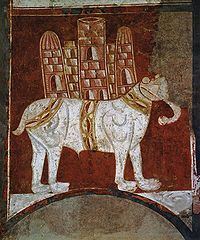 | ||
Abul-Abbas (also Abul Abaz or Abulabaz) was an Asian elephant given to Carolingian emperor Charlemagne by the Abbasid caliph Harun al-Rashid. The elephant's name and events from his life are recorded in the Carolingian Annales regni Francorum, and he is mentioned in Einhard's Vita Karoli Magni. However, no references to the gift or to interactions with Charlemagne have been found in Abbasid records.
Contents
From the Orient to Europe
Abul-Abbas was brought from Baghdad, the capital city of the Abbasid empire, by a Frankish Jew named Isaac, who along with two other emissaries, Lantfrid and Sigimund, had been sent to the caliph on Charlemagne's orders. That the only surviving member of the group of three, Isaac, was being sent back with the elephant was heralded as advance news to Charlemagne from two emissaries he met in 801: one was sent by the caliph Harun al-Rashid himself, another by Abraham (Ibrahim ibn al-Aghlab), who was governor of Africa. Charlemagne then ordered a man to Liguria (the province around Genoa) to commission a fleet of ships to carry the elephant and other goods.
Researchers have speculated on Isaac and the elephant's route through Africa: Isaac and the elephant began the trek back by following the Egyptian coast into Ifriqiya, ruled by Ibrahim ibn al-Aghlab who had bought the land from al-Rashid for 40,000 dinars annually. Possibly with the help of Ibrahim in the capital city of Kairouan (now in Tunisia), Isaac set sail from port (possibly Carthage, now in Tunisia) with Abul-Abbas and traveled the remaining distance to Europe via the Mediterranean Sea.
At any rate, the strict reading of the historic text Annales regni Francorum is that "Isaac the Jew returned from Africa" (Isaac Iudeus de Africa cum elefanto ) and landed in Porto Venere (near Genoa) in October 801. The two spent the winter in Vercelli, and in the spring they started the march over the Alps to the Emperor's residence in Aachen, arriving on 20 July 802.
Death
In the year 810, Charlemagne left his palace and mounted a campaign intending to engage with King Godofrid of Denmark and his fleet that invaded and plundered Friesland. Charlemagne had crossed the Rhine River and tarried at a place called "Lippeham" awaiting troops for three days, when his elephant suddenly died. On the tacit assumption that the Abul-Abbas was with Charlemagne when he died, some modern commentators venture that the beast had been brought to serve as a war elephant.
Place of death
The location of "Lippeham" is a matter of conjecture, but has been placed at the "mouth of the Lippe River" (its confluence with the Rhine), in other words, somewhere near the city of Wesel. The claim dates at least as far back as 1746 (or even 1735), when J. H. Nünning (Nunningus) and colleague published a notice that "Lippeham" was to be identified with Wesel; and that a colossal bone unearthed from the area, in the possession of their affiliated museum, was plausibly a part of the remains of the elephant Abul Abbas. Another gigantic bone was found in the Lippe River among a catch of fish in the herrschaft of Gartrop in early 1750, and it too was claimed to be a piece of Abul Abbas.
One detractor to the claim is Richard Hodges who places it in Lüneburg Heath, which is nowhere near the Rhine.
Details of exhibition and death
The Annales regni Francorum contain only short reports about the transport of Abul-Abbas (801), his delivery to the Emperor (802) and his death (810). But modern writers have given various embellished accounts. Some indicate that when Abul-Abbas arrived, he was marched through various towns in Germany to the astonishment of onlookers, that he was shown in "Speyer, Strassburg, Verdun, Augsburg, and Paderborn" as ostentatious display of the emperor's might, and was eventually housed in Augsburg in what is now southern Bavaria.
Some add details about the elephant's death, stating he was in his forties and already suffering from rheumatism when it accompanied Charlemagne in the campaign across the Rhine heading to Friesland. According to these sources, in a spell of "cool rainy weather", Abul-Abbas developed a case of pneumonia. His keepers were able to transport the beast as far as Münster, where he collapsed and died.
White elephant
Some modern works indicate that Abul-Abbas was albino – literally a white elephant – but the basis for the claim is wanting. An early example claiming that Abul-Abbas was a "white elephant" occurs in a title authored by Willis Mason West (1902), In 1971, Peter Munz wrote a book intended for popular readership which repeated the same "white elephant" claim, but a reviewer flagged this as a "slip" given there was "no evidence" known to him to substantiate it. Mention of "white elephant" also misleadingly occurs in the title of the published catalog from the Aachen exhibition of 2003: Ex oriente : Isaak und der weisse Elefant, however, in this publication is a contributing article by Grewe and Pohle that appends a question mark on it: "Among the famous gifts to Charlemagne was a (white?) elephant".
Indian elephant
A number of authors have also asserted with seemingly unwavering certitude that Abul-Abbas was an Indian elephant, though others cast this as an open question with the African elephant being a distinct possibility.
